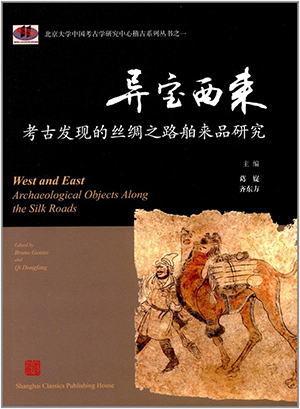Exploring exotic relics along the Silk Road

West and East: Archaeological Objects along the Silk Roads
Editor-in-chief: Qi Dongfang and Bruno Genito
Publisher: Shanghai Classics Publishing House
West and East: Archaeological Objects along the Silk Roads is the result of an eightyear collaborative research project involving the School of Archaeology and Museology at Peking University and the Department of Asian, African and Mediterranean Studies at the University of Naples “L’Orientale,” Italy.
According to Han Dynasty literature, the Silk Road, with Chang’an as the starting point, gradually formed in the second century BCE. This was around the time envoy Zhang Qian traveled to the Western Regions. The Central Plains Dynasty launched exchange missions with various countries in the Western Region and started inter-governmental negotiations. In the middle of the seventh century, the Western Turks surrendered to the Tang Dynasty and the Silk Road became a smooth route. Thereafter, the route was loaded with merchants and tourists.
Numerous cultures have records of this region. The Sakas mentioned in the Iranian literature of the Iron Age, the Xiongnu and Wusun, and even the Rouzhi people, are either not seen in the Han literature, or they received a passing mention. These cultures also engaged in trade. Therefore, before the Silk Road was formed, there had already been a “Jade Road,” “Salt Road,” “Amber Road” and “Incense Road.”
After the Common Era, the Kushan Empire, the Sassanid Empire and the Sogdiana tribes that had close contact with China in terms of materials and culture, each played their own key roles in the region. By the end of the first century, the rise of the Kushan Empire formed by Indian-Scythians and Greeks had effectively controlled the trade and commerce along the west of the Taklama Basin, the Indus Valley, Central Asia and the Aral Sea. Around the third century, the Samarkand region was controlled by the Sassanid Empire. Among them, as one of the important political entities, the Sogdian people started from Samarkand and arrived in Iran to the West and China to the East. They had been known on the Silk Road as the “shrewdest businessman in the world from East Iran to East Turkistan.” Some Sogdians even resided in China and became officials in areas outside of commerce.
In the 14th century, Marco Polo’s account of communication between the East-West trade route began historical records of the road in the Western world. In 1877, the German geographer Ferdinand von Richthofen proposed the concept of the “Silk Road.” In the late 19th century and early 20th century, explorers represented by Sven Heding, Marc Aurel Stein, A·Grünwedel and Albert von LeCoq once again presented the Western Regions to the world.
Over the past 150 years, the continuous discovery of newly unearthed documents and archaeological sites has enabled the study of ancient languages, history, and archaeology in the Western Regions to gain popularity. Because of its vast and rich cultures, the Western Region has become a highly dynamic academic field. In this light, scholars from Peking University and University of Naples “L’Orientale” examined the relics that have a distinct exotic origin, aiming to provide a set of documentaries and a historical interpretation framework.
(edited by SUI JINGJING)
